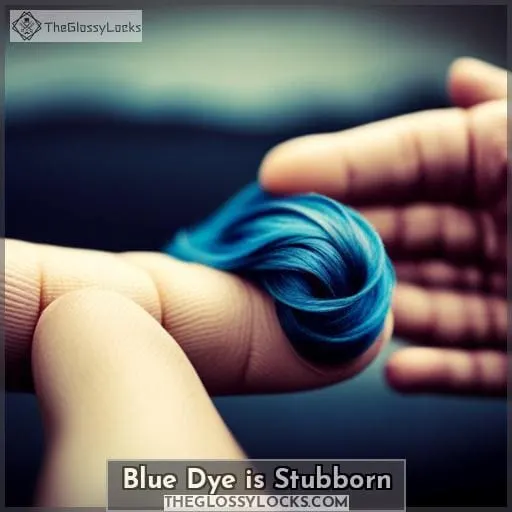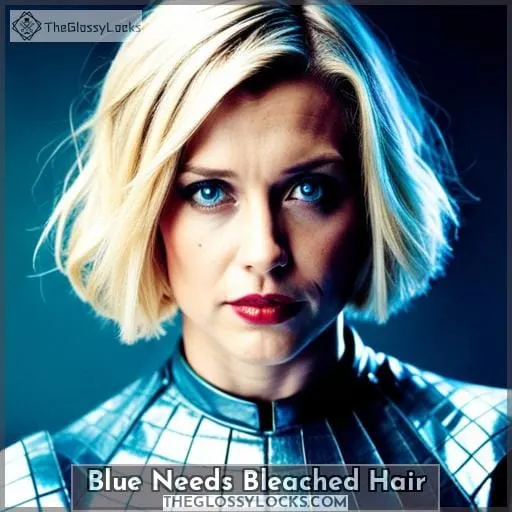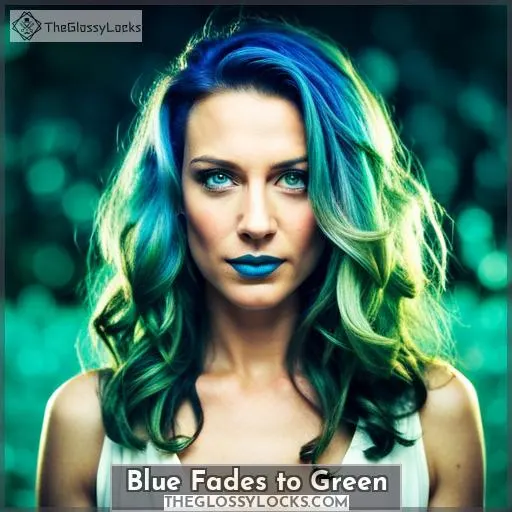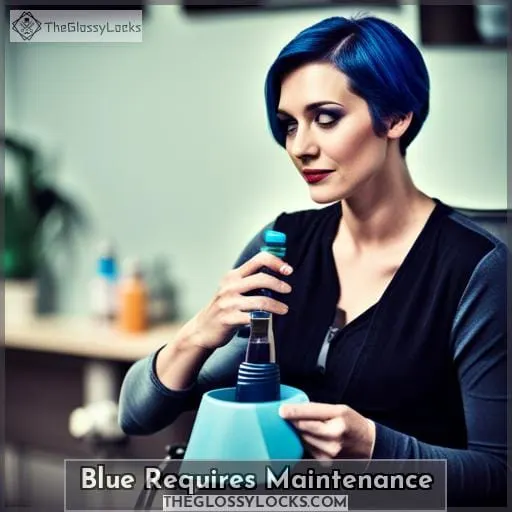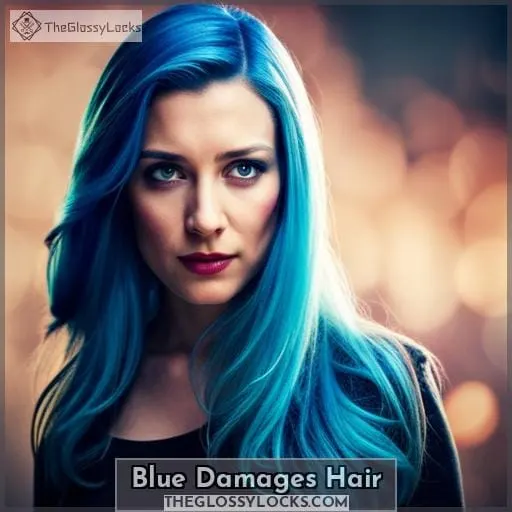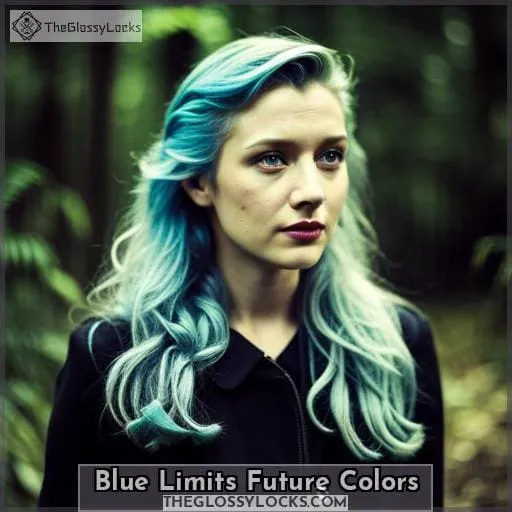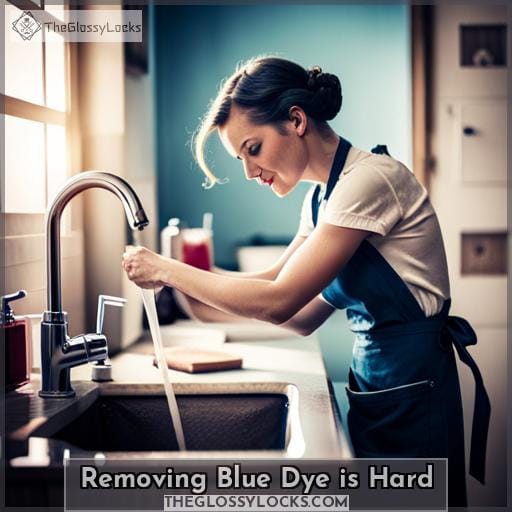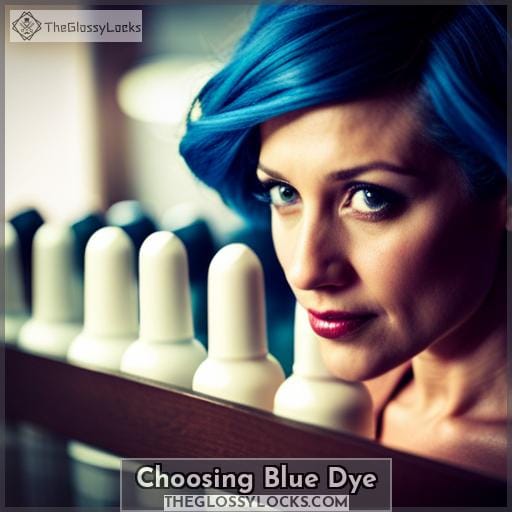This site is supported by our readers. We may earn a commission, at no cost to you, if you purchase through links.
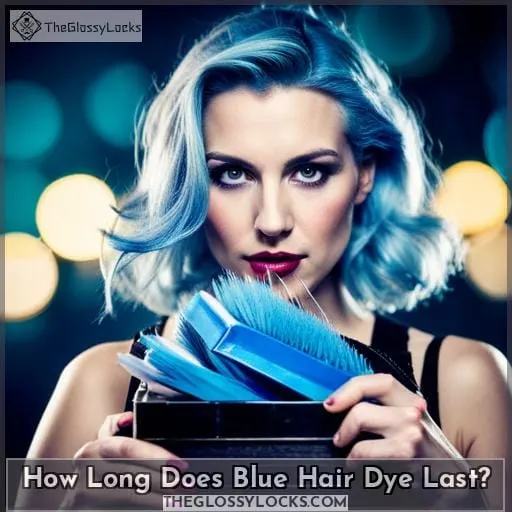
In this article, we’ll dive deep into the world of blue hair dye and uncover just how long you can expect that stunning hue to stick around. From fading to maintenance tips, we’ll provide all the information you need for your journey with blue locks.
Table Of Contents
- Key Takeaways
- Blue Dye is Stubborn
- Blue Needs Bleached Hair
- Blue Fades to Green
- Blue Requires Maintenance
- Blue Damages Hair
- Blue Limits Future Colors
- Removing Blue Dye is Hard
- Choosing Blue Dye
- Frequently Asked Questions (FAQs)
- What are some common mistakes people make when trying to remove blue hair dye?
- How often should blue hair dye be touched up to maintain the desired color?
- Are there any alternative methods to bleach for achieving a light enough base for blue hair dye?
- Can blue hair dye be used on darker hair colors without bleaching?
- What are some tips for minimizing damage to hair when dyeing it blue?
- Conclusion
Key Takeaways
- Blue dye fades to green over time due to oxidation.
- Maintaining blue hair requires using color-safe products, minimizing washing, and protecting from sun exposure.
- Blue dye can damage hair by stripping moisture and limiting future color options.
- Removing blue dye can be challenging and may require dye remover, bleach, or color correction.
Blue Dye is Stubborn
Blue hair dye is known to be incredibly stubborn and long-lasting, often requiring a significant amount of effort to fade or remove completely.
Over time, the vibrant blue color will begin to fade into shades of teal and pastel green before eventually settling into a subtle green tint. This fading process can take anywhere from one month for teal tones up to two months for pastel green hues.
To prolong the life of your blue hair color, it’s essential to use color-safe products and avoid washing too frequently with hot water that can strip away the dye molecules.
However, when you decide it’s time for a new look or want an escape from the boldness of blue hair, removing this stubborn hue may require more than just regular shampooing – consider using safe products designed specifically for hair dye removal or even resorting bleaching techniques if necessary.
Blue Needs Bleached Hair
To achieve that vibrant and long-lasting pastel blue hair color, you’ll need to start with light blonde hair.
Blue dye doesn’t adhere well to darker shades, which means bleaching is necessary for the best results. Bleaching your hair helps remove any existing pigments and creates a blank canvas for the blue dye to take hold.
Bleached hair provides a lighter base, allowing the true shade of blue to shine through without interference from underlying tones. Without properly bleached hair, you may end up with an undesirable green tint instead of that desired pastel blue hue.
It’s important to note that bleach can be damaging if not used correctly or if left on for too long. It’s recommended to seek professional help when it comes to bleaching your own hair or consult reliable resources before attempting it yourself.
Once your locks are prepped and ready with light blonde strands, you’re one step closer towards achieving stunningly vibrant blue tresses!
Blue Fades to Green
As your vibrant blue hair begins to age, it gradually transforms into a beautiful shade of green.
- Gradual change: The fading process takes time, with the blue dye breaking down over weeks or months until the underlying green pigment becomes more visible.
- Unique shades: The resulting green hair color can vary depending on factors like your original base color and the specific brand of blue dye used.
- Maintenance is key: To keep your green hue looking fresh and vibrant, consider using specialized products for maintaining colored hair such as sulfate-free shampoo designed for dyed hair.
Embrace this evolution from bold blues to enchanting greens as you embark on your colorful hairstyle journey!
Blue Requires Maintenance
To maintain the vibrant blue color of your hair dye, it’s important to follow a few maintenance tips.
First, use color-safe shampoo and conditioner specifically designed for colored hair to help preserve the hue.
Additionally, try not to wash your hair too often as frequent washing can cause the color to fade more quickly.
Lastly, protect your hair from excessive sun exposure by wearing hats or using UV-protective sprays or serums.
Use Color-Safe Products
To maintain the vibrant color of your blue hair, use color-safe products.
Avoid hot water and hair products with alcohol.
Opt for sulfate-free shampoo and conditioner to prevent fading.
Deep condition regularly, trim split ends, and follow a proper aftercare routine for long-lasting blue hair dye.
Avoid Washing Too Often
When dying your hair blue, don’t wash it too often if you want the vibrant color to last.
Washing hair too frequently dries it out, causing itchy scalp, split ends, hair fall and overall damage.
To keep your blue hair dye looking fresh, avoid over-washing and use a hydrating conditioner to prevent dry, damaged hair.
Protect From Sun
Protect your blue hair from sun exposure to maintain its vibrant color and prevent fading.
- Wear hats and scarves outside.
- Carry an umbrella on sunny days.
- Stay in the shade to avoid direct sunlight hittin’ your blue hair and makin’ it fade faster than you want.
Blue Damages Hair
Using blue hair dye can cause damage to your hair due to the harsh chemicals it contains.
The vibrant and eye-catching color of blue hair comes at a cost, as the dye has the potential to stain not only your strands but also various surfaces such as skin, clothes, towels, pillows, and even showers.
The chemicals in blue hair dye can be drying and damaging to your locks over time. They strip away moisture from your strands, leaving them dry and brittle. This damage may result in breakage or split ends if proper care isn’t taken.
To minimize potential damage caused by blue hair dye, ensure you use high-quality products specifically formulated for colored hair and follow recommended maintenance routines like deep conditioning treatments regularly.
Blue Limits Future Colors
With you having blue hair, your options for other hair colors become limited after the fact.
While it might seem exciting to experiment with different shades and hues, the vibrant nature of blue dye can pose a challenge when transitioning to other colors.
Blue tends to linger in the hair even after multiple washes, making it difficult for new pigments to take hold.
If you’ve been rocking a bold blue hue, your future color choices may be restricted mainly to:
- Pastels like muted pinks or lavenders
- Muddy browns or muted reds that blend well with remnants of the blue pigment still present in your strands
- Ashy blondes and warm purples as they’ve cooler undertones that can complement any remaining traces of teal from fading blue dye.
Removing Blue Dye is Hard
Getting rid of blue hair dye can be challenging to deal with on your own. Here are four reasons why removing blue dye is hard:
- Dye removers: Regular shampoo may not be enough to remove the stubborn blue pigment from your hair. You may need specialized color removers or clarifying shampoos designed specifically for this purpose.
- Bleach: If you want to completely get rid of the blue color, bleaching your hair might be necessary. However, bleach can damage your hair if not used properly and should only be done by a professional.
Choosing Blue Dye
When choosing blue hair dye, it’s important to consider the brand and quality of the product.
Look for a dye that’s formulated specifically for vibrant, long-lasting color.
Additionally, pay attention to reviews and recommendations from others who’ve used the dye before in order to gauge its effectiveness and longevity.
Lastly, consider your own hair type and condition as this can also impact how well the color will adhere and last on your strands.
Best blue hair dye
You can find the best blue hair dye by researching different brands and reading reviews.
Look for dyes specifically formulated for:
- Light blue
- Dark blue
- Natural blue
- Pastel blue
- Vibrant blue
Consider factors such as:
- Longevity
- Color payoff
- Damage
to make an informed decision.
Preventing dye from fading
To prevent your blue hair dye from fading quickly, choose a high-quality and long-lasting dye that’s specifically formulated for vibrant colors.
Here are some tips to help you maintain the color:
- Use cold water when washing your hair.
- Dry your hair thoroughly before styling.
- Avoid heat styling tools as they can fade the color.
- Use clarifying shampoo to remove buildup and keep the color vibrant.
Removing blue hair dye
To remove blue hair dye, consider using a color remover or bleach for effective results.
Here are some options to help you get rid of the blue hue in your hair:
| Method | Description | Pros |
|---|---|---|
| Color Remover | Removes color without damaging the hair | Gentle on the strands |
| Bleach | Removes all pigment from the hair | Effective at lightening and removing stubborn colors |
| Salon Help | Seek professional assistance for safe and effective removal | Expert guidance |
Choose an option that suits your needs and consult a salon if necessary.
Frequently Asked Questions (FAQs)
What are some common mistakes people make when trying to remove blue hair dye?
When trying to remove blue hair dye, common mistakes include:
- Using harsh color removers or bleach without proper knowledge or guidance.
These methods can lead to further damage and may not completely remove the blue pigment.
Seek professional advice for safe and effective removal techniques.
How often should blue hair dye be touched up to maintain the desired color?
To maintain the desired color of blue hair dye, touch-ups should be done every 4-6 weeks.
This will help keep the color vibrant and prevent it from fading or turning green.
Regular maintenance is key for long-lasting results.
Are there any alternative methods to bleach for achieving a light enough base for blue hair dye?
If you want to avoid using bleach, consider using:
- A high-lift hair color
- a color remover
to achieve the light base needed for blue hair dye.
These alternatives can help maintain the health of your hair while still achieving your desired look.
Can blue hair dye be used on darker hair colors without bleaching?
Blue hair dye requires pre-lightened hair to show true color.
On unbleached dark hair, blue dye will look darker, muted, lacking vibrancy.
Consider bleaching for best results, or try lighter fashion colors first before committing to such a drastic change.
What are some tips for minimizing damage to hair when dyeing it blue?
Minimize damage when dyeing your hair blue by:
- Using a color-safe shampoo and conditioner
- Washing less frequently with cool water
- Avoiding alcohol-based products
- Protecting from the sun’s rays.
But hey, who needs healthy hair anyway?
Conclusion
In the enchanting world of blue hair dye, the stunning hue may not last as long as you hope.
Blue dye is notorious for being stubborn and requires bleached hair for optimal results.
While blue hair may fade to a greenish tint over time, proper maintenance can help prolong the vibrancy.
However, it’s important to note that blue dye can damage your hair and limit your options for future colors.
Removing blue dye can also be a challenging task.
So, choose your blue dye wisely and be prepared for the journey ahead.

